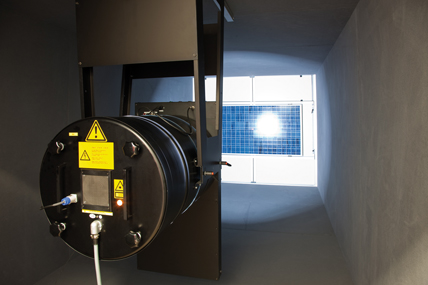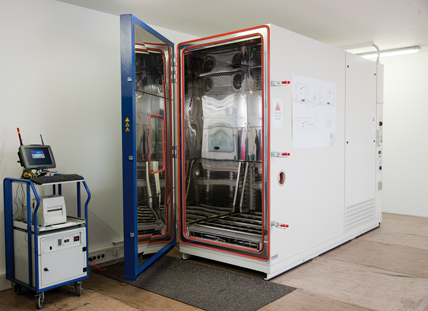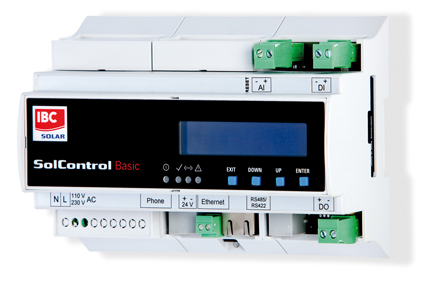Quality matters
Nowadays a whole range of technologies and techniques exist to ensure the quality of photovoltaic installations, from module testing to system monitoring. Marco Siller, Director Product Management / Product Development, from IBC Solar explains what is necessary to ensure high-quality, reliable photovoltaic installations.
Solar panels are built to last for over 20 years, and therefore careful installation is essential. Ensuring correct testing and mounting of photovoltaic modules is of paramount importance, as even overlooking seemingly minor points during installation can have a massive effect on the output of the modules. Yet there are other factors worth considering. Even when the installation of the modules is carried out faultlessly, the output can fail.
In this case the modules are sent back to the manu-facturer to be replaced. As this process is expensive and also means image loss for the manufacturer, the modules are tested vigorously before installation.
Testing the Modules
Institutes such as the Fraunhofer Institute for Solar Energy Systems (ISE) test solar modules. The Fraunhofer Institute conducts research on the technology needed to supply energy efficiently and on an environmentally sound basis in industrialised, threshold and developing countries. The Institute‘s work ranges from fundamental scientific research relating to solar energy applications, through the development of production technology and prototypes, to the construction of demonstration systems. The Institute plans, advises and provides know-how and technical facilities as services (www.ise.fraunhofer.de). IBC SOLAR started to conduct its own tests in order to meet growing market needs. IBC SOLAR has set up a test laboratory for solar modules, in addition to regular tests at Fraunhofer ISE, where tests measure the endurance and performance of the modules.
###newpage###
The Flasher
In order to test the actual power output of the modules from the individual manufacturers, the modules are put through a "Flasher”. After tempering the modules at 25 °C in a climatized room with 30 % humidity for two days, a ray of light simulating sunlight is "flashed” at the module. The flasher lamp is charged by a condensator battery and depending on the energy produced by the condensator, it emits a beam of light with an intensity up to 1100 W/m2. By regulating the charging of the condensator and the filter settings, the intensity and the spectrum of the flash of light can be calibrated. The beam recreates the spectrum of sunlight and lasts 10 mS.
The energy produced from the flash in the solar module is read from the access line by highly precise measuring systems. Software then creates a current-voltage characteristic from these points of measurement, which is shown graphically as a curve. This enables the tester to easily detect problems with the module if the curve and the electrical values differ from the norm.
In order to ensure that the tests are carried out to industry standards, IBC SOLAR works together with accredited institutes such as the Fraunhofer Institute. According to Norbert Hahn, member of the IBC SOLAR executive board: "Our flasher has been calibrated in cooperation with the Fraunhofer Institute, so that we practically measure the same values as the Institute, especially in the case of crystalline modules. If the test results are indecisive, we conduct further tests at the Fraunhofer ISE.”

The IBC SOLAR-Flasher
###newpage###
The Environmental Chamber
A second important step in the testing process is the environmental chamber. The environmental chamber simulates long term tests to withstand certain environmental conditions. It examines the quality of the laminate when exposed to extreme temperatures and varying humidity. Modules are tested at a range of temperatures from -40 °C to +85 °C and at humidity factors up to 85 %. Various tests are possible in the climate chamber, including the temperature cycling test and the humidity test.
In the temperature cycling test, the temperature changes from -40 °C to +85 °C according to a defined profile. The maximum duration of this test is 6 hours per cycle. It is generally recommended that in the certifications process the module goes through 200 cycles. However, IBC SOLAR puts its test modules through 500 cycles in order to fully test their durability. The aim of the test is to test the PV modules for problems such as thermal maladjustment or fatigue of material.
The Damp-Heat-Test involves heating the module at 85 °C for 1000 hours in an atmosphere with humidity of 85 %. The aim of the test is to test the suitability of the modules with regards to its ability to withstand the long-term penetration of air humidity.
###newpage###

The Environmental Chamber
Installation
During installation, installation partners can take simple steps to ensure high yields. Installing the modules correctly is decisive as irrespective of the quality of the modules, faulty installation can lead to a loss of output. Attaching the modules in the correct place prevents cracks in the glass of the modules, which eventually lead to cell failure. Incorrect installation of components such as the inverter can lead to damage and an unreliable system. Above all, following the guidelines of the manufacturer is crucial. This includes the choice of output cables, the wiring, as well as the positioning of the modules. All this ensures that the guarantee remains valid as it is not possible to claim back on faulty modules if the fault is due to incorrect installation.
###newpage###
Careful planning should be undertaken with regards to the placement and the angle of the modules. Objects that cast shadows must be taken into account, whether the module is a roof or ground installation. On roofs these can include chimneys, gables or solar generators. Constant shadow is a particular danger as it can cause cell failure. Sporadic shadow can make a huge difference to the output of the modules. Other objects which can disturb the working of the solar generator (the modules, the inverter and the battery) itself might include trees, or other plant growth. For example, if shaded by as much as a leafless tree branch, a PV module could lose up to 80 % of its output ( howto.altestore.com/Getting-Started-with-Renewable-Energy/Introduction-to-Solar-Electricity/a89). In the case of ground installations, or installations on a flat roof, the precaution of ensuring that the modules are far enough apart from each other will prevent the modules casting shadows on each other and thereby hindering energy output.
When installing the modules, great care must be taken when attaching them to the supports. The fixing of the modules must take place within a very precise area on the modules, according to the manufacturers’ guidelines. If the modules are attached outside this area, the glass of the modules is at risk of breaking under weight (e.g. snowfall).
###newpage###

The monitoring system "SolControl”
Apart from the modules, the inverter is an extremely important part of the system as it is often the first part of the PV system to fail. Installing and maintaining the inverter correctly can have a large effect on its lifespan. Dimensioning the inverter should happen in relation to the angle and alignment of the solar generator. "In our experience, an energetically optimal relationship between the module output and the maximum inverter input in a module facing in a southerly direction lies between 95 % and 108 % in Germany”, explains Markus Maier, Director Services & Engineering of IBC SOLAR. Protecting the inverter is also important, and what is required depends entirely on the location of the installation, whether deciding factors are dirt, dust, sand or damp, for example.
###newpage###
Post-Installation
Once the system has been turned on, the PV modules must be tested to make sure that there are no faults. Ideally, a PV system should be in continuous use with a yearly maintenance check. Although PV systems are basically maintenance-free, a yearly check-up is necessary to ensure everything is running smoothly. After a while, possible problems that occur could include frost damage, defect bypass diodes, hotspots or simply not enough performance. There are several techniques available to detect such problems including characteristic curve measurement or infra-red thermography.
Furthermore, constant surveillance is essential for a PV system, in order to be able to detect problems as soon as they arise. There are various systems for this on the market including IBC SOLAR’s own monitoring system, the IBC Solat "SolControl”.
Initially, the monitoring system carries out a target/actual analysis of up-to-date weather data. If required, additional sensors can be attached to measure the current weather data and irradiation values. With this data, the system simulates how much electricity the installation should theoretically produce and recognises each variation in the actual system performance from the target value. If the output fails, the monitoring system sends a text message to the maintenance team so that they can begin looking for the error. With this system, maintenance teams worldwide can access the system data from anywhere over any standard web browser and can then identify possible sources of error such as a cable failure, dirty module, etc. This constant surveillance means that a problem is spotted immediately and down time is minimised through rapid intervention. The integrated reporting function sends out the system results to several recipients at pre-defined intervals (once a day / week / month / year etc).
In order to ensure that the photovoltaic installation lasts over 20 years as intended, careful quality control is key. Quality control is very important before and during the installation process and should continue after the system has been put into operation. It ensures that the investment in the PV system is safe and profitable.
###newpage###
Qualität ist niemals Zufall
Es gibt eine große Bandbreite an Technologien zur Qualitätssicherung bei Photovoltaik-Installationen: vom Modultest bis zur Anlagenüberwachung. Marco Siller (Direktor Produktmanagement / Produktentwicklung) von IBC SOLAR erklärt in dem vorliegenden Beitrag, welche Maßnahmen nötig sind für qualitativ hochwertige, zuverlässige PV-Anlagen.

The testcenter in Hafenpreppach.
Kontakt:
IBC SOLAR AG, 96231 Bad Staffelstein
Tel. +49 9573 92240, Fax +49 151 11737679
Marco.Siller@ibc-solar.de, www.ibc-solar.de



